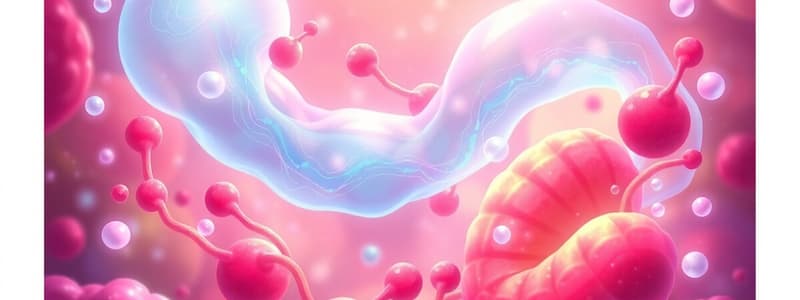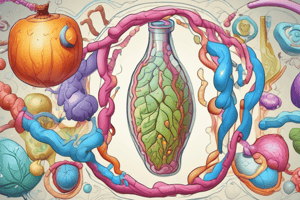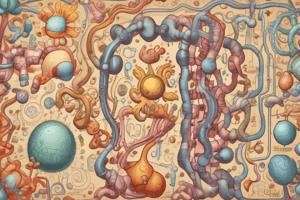Podcast
Questions and Answers
What is the maximum carbon length at which humans can insert a double bond in fatty acids?
What is the maximum carbon length at which humans can insert a double bond in fatty acids?
- 6 carbons
- 18 carbons
- 12 carbons
- 9 carbons (correct)
Which fatty acids are classified as essential components of the human diet due to their role in synthesizing polyunsaturated fatty acids?
Which fatty acids are classified as essential components of the human diet due to their role in synthesizing polyunsaturated fatty acids?
- Linoleic acid and Alpha-linolenic acid (correct)
- Palmitic acid and Linoleic acid
- Oleic acid and Stearic acid
- Arachidonic acid and Eicosapentaenoic acid
What is arachidonate derived from?
What is arachidonate derived from?
- Oleic acid
- Stearic acid
- Palmitate
- Linoleate (correct)
Which of the following options correctly identifies the role of eicosanoids?
Which of the following options correctly identifies the role of eicosanoids?
How do humans synthesize the full complement of polyunsaturated fatty acids from linoleic acid and alpha-linolenic acid?
How do humans synthesize the full complement of polyunsaturated fatty acids from linoleic acid and alpha-linolenic acid?
Which of the following is NOT a classification of eicosanoids?
Which of the following is NOT a classification of eicosanoids?
What is the effect of inserting double bonds in fatty acids on their melting temperature?
What is the effect of inserting double bonds in fatty acids on their melting temperature?
Which tissue primarily utilizes arachidonate for the synthesis of eicosanoids?
Which tissue primarily utilizes arachidonate for the synthesis of eicosanoids?
What is the primary functional role of Acetyl-CoA in lipid metabolism?
What is the primary functional role of Acetyl-CoA in lipid metabolism?
Which fatty acid typically has a carbon chain length that is physiologically significant?
Which fatty acid typically has a carbon chain length that is physiologically significant?
What is the role of pyrophosphatases in biochemical reactions?
What is the role of pyrophosphatases in biochemical reactions?
What is the significance of Linoleate and a-Linolenate in fatty acid metabolism?
What is the significance of Linoleate and a-Linolenate in fatty acid metabolism?
What is the primary role of Acetyl-CoA in palmitate synthesis?
What is the primary role of Acetyl-CoA in palmitate synthesis?
What is a primary function of the ketoacyl synthase activity within the fatty acid synthase complex?
What is a primary function of the ketoacyl synthase activity within the fatty acid synthase complex?
Which enzyme is primarily responsible for increasing the chemical reactivity of Acetyl-CoA?
Which enzyme is primarily responsible for increasing the chemical reactivity of Acetyl-CoA?
Which of the following statements about cyclooxygenases COX-1 and COX-2 is true?
Which of the following statements about cyclooxygenases COX-1 and COX-2 is true?
What is the role of phosphopantetheine in fatty acid synthesis?
What is the role of phosphopantetheine in fatty acid synthesis?
Which process provides the majority of NADPH required for palmitate synthesis?
Which process provides the majority of NADPH required for palmitate synthesis?
What is the mechanism through which malate can generate NADPH during fatty acid synthesis?
What is the mechanism through which malate can generate NADPH during fatty acid synthesis?
What is a key step in the fatty acid synthesis cycle?
What is a key step in the fatty acid synthesis cycle?
In palmitate synthesis, how many times is the enzyme-catalyzed process repeated to produce a full chain?
In palmitate synthesis, how many times is the enzyme-catalyzed process repeated to produce a full chain?
What is the function of the citrate transporter in fatty acid synthesis?
What is the function of the citrate transporter in fatty acid synthesis?
What transformation occurs during the first step of the enzyme-catalyzed process of fatty acid elongation?
What transformation occurs during the first step of the enzyme-catalyzed process of fatty acid elongation?
Which best describes the role of pyruvate in the fatty acid synthesis pathway?
Which best describes the role of pyruvate in the fatty acid synthesis pathway?
What is the role of Acetyl Transferase in the fatty acid synthesis process?
What is the role of Acetyl Transferase in the fatty acid synthesis process?
During which reaction does a carboxylate bond break, releasing CO2?
During which reaction does a carboxylate bond break, releasing CO2?
What compound is used to provide reducing equivalents in the Beta-Ketoacyl Reductase reaction?
What compound is used to provide reducing equivalents in the Beta-Ketoacyl Reductase reaction?
What happens during the Beta-Hydroxyacyl Dehydratase reaction?
What happens during the Beta-Hydroxyacyl Dehydratase reaction?
Which of the following enzymes is responsible for hydrolyzing the thioester bond between palmitate and ACP?
Which of the following enzymes is responsible for hydrolyzing the thioester bond between palmitate and ACP?
What is formed after the Beta-Enoyl Reductase reaction?
What is formed after the Beta-Enoyl Reductase reaction?
What initiates the fatty acid synthesis by providing the first carbon to the FAS?
What initiates the fatty acid synthesis by providing the first carbon to the FAS?
Which intermediate is attached to phosphopantetheine during the fatty acid synthesis?
Which intermediate is attached to phosphopantetheine during the fatty acid synthesis?
What is the primary reason corticosteroids are considered anti-inflammatory?
What is the primary reason corticosteroids are considered anti-inflammatory?
Which statement correctly differentiates between COX-1 and COX-2?
Which statement correctly differentiates between COX-1 and COX-2?
What is the consequence of inhibiting thromboxane synthesis in blood platelets?
What is the consequence of inhibiting thromboxane synthesis in blood platelets?
Which enzymatic activity is NOT associated with PGH2 Synthase?
Which enzymatic activity is NOT associated with PGH2 Synthase?
What is the main role of lipoxygenases in arachidonate metabolism?
What is the main role of lipoxygenases in arachidonate metabolism?
Which of the following statements about NSAIDs is incorrect?
Which of the following statements about NSAIDs is incorrect?
Which condition typically results in increased levels of COX-2 expression?
Which condition typically results in increased levels of COX-2 expression?
Why is aspirin considered effective for long-term inhibition of thromboxane synthesis in platelets?
Why is aspirin considered effective for long-term inhibition of thromboxane synthesis in platelets?
Flashcards
Acetyl-CoA
Acetyl-CoA
Activated form of acetic acid, a high-energy intermediate crucial for lipid metabolism.
Fatty Acid Structure
Fatty Acid Structure
Monocarboxylic hydrocarbons with varying carbon chains (5-26 carbons).
Palmitate (16:0)
Palmitate (16:0)
Primary product of fatty acid synthesis, a 16-carbon fatty acid.
Fatty Acid Synthesis
Fatty Acid Synthesis
Signup and view all the flashcards
Citrate Shuttle
Citrate Shuttle
Signup and view all the flashcards
Acetyl-CoA Carboxylase
Acetyl-CoA Carboxylase
Signup and view all the flashcards
Malonyl-CoA
Malonyl-CoA
Signup and view all the flashcards
Fatty Acid Synthase (FAS)
Fatty Acid Synthase (FAS)
Signup and view all the flashcards
Phosphopantetheine
Phosphopantetheine
Signup and view all the flashcards
Fatty Acid Activation
Fatty Acid Activation
Signup and view all the flashcards
Fatty Acid Elongation
Fatty Acid Elongation
Signup and view all the flashcards
Fatty Acid Desaturation
Fatty Acid Desaturation
Signup and view all the flashcards
Essential Fatty Acids
Essential Fatty Acids
Signup and view all the flashcards
Linoleate and α-linolenate
Linoleate and α-linolenate
Signup and view all the flashcards
Eicosanoids
Eicosanoids
Signup and view all the flashcards
Prostaglandin H2 Synthase (COX)
Prostaglandin H2 Synthase (COX)
Signup and view all the flashcards
COX-1 and COX-2
COX-1 and COX-2
Signup and view all the flashcards
COX Inhibitors (NSAIDs)
COX Inhibitors (NSAIDs)
Signup and view all the flashcards
Arachidonate
Arachidonate
Signup and view all the flashcards
Lipoxygenases
Lipoxygenases
Signup and view all the flashcards
Myristate (C14:0)
Myristate (C14:0)
Signup and view all the flashcards
Stearate (C18:0)
Stearate (C18:0)
Signup and view all the flashcards
Phospholipase A2 (PLA2)
Phospholipase A2 (PLA2)
Signup and view all the flashcards
Study Notes
All Lipids are Derived from Acetyl-CoA
- Acetyl-CoA is an activated form of acetic acid
- It is a high-energy intermediate due to the thioester bond
- Acetyl-CoA plays a central role in lipid metabolism just like G6P in carbohydrate metabolism
Fatty Acid (FA) Structure and Nomenclature
- Fatty acids are monocarboxylic hydrocarbons with varying carbon chain lengths (5-26 carbons)
- Physiologically important FAs typically have chain lengths of 16-18 carbons
- Palmitate (16:0) is the primary product of de novo FA synthesis
Key Points about Fat Synthesis
- Palmitate synthesis requires Acetyl-CoA, ATP, NADPH, and two enzymes: Acetyl-CoA Carboxylase and Fatty Acid Synthase
- All palmitate carbons originate from Acetyl-CoA, added two carbons at a time
- Fatty acid synthesis takes place in the cytoplasm
Transfer of Acetyl-CoA from Mitochondrial Matrix to Cytosol
- Acetyl-CoA is produced in the mitochondrial matrix
- There is no membrane carrier for acetyl-CoA, but there is a carrier for citrate
- The Citrate Shuttle allows the continuous production of citrate in mitochondria and its cleavage in the cytoplasm
Acetyl-CoA Carboxylase: Activating the Acetyl Methyl Carbon
- Acetyl-CoA carboxylase catalyzes the carboxylation of acetyl-CoA to malonyl-CoA
- This activation step is required for the elongation of fatty acid chains
Palmitate (C16:0 FA) Synthesis by the Multifunctional Fatty Acid Synthase (FAS)
- Phosphopantetheine acts as an acyl group carrier during fatty acid synthesis
- FAS is a multifunctional enzyme with distinct domains responsible for specific reactions
- The FAS reaction cycle involves 7 repeated rounds of elongation and reduction
- The cycle is initiated by priming with acetyl-CoA
- The cycle involves recursive rounds of elongation and reduction
- The process concludes with hydrolytic release of palmitate
Alternate FA Products of the FAS
- FAS can also produce alternate FA products like myristate (C14:0) and stearate (C18:0)
Fatty Acid Neutralization and Activation for Group Transfer Reactions
- Newly synthesized fatty acids need to be activated for further metabolism
- Activation involves the attachment of CoA to form fatty acyl-CoA
Fatty Acid Elongation and Desaturation
- After palmitate synthesis, fatty acids can be elongated and desaturated
- Elongation adds two carbons to the fatty acid chain
- Desaturation introduces double bonds into the fatty acid chain
Essential Fatty Acids: Linoleate and α-linolenate
- Linoleate (ω-6 FA) and α-linolenate (ω-3 FA) are essential fatty acids
- They contain double bonds beyond carbon-9, which cannot be introduced by human enzymes
Fatty Acid-Derived Signaling Molecules: Eicosanoids
- Eicosanoids are a family of short-lived signaling molecules
- They act as local hormones, exerting effects on nearby cells
- Eicosanoid classes include prostaglandins, leukotrienes, thromboxanes, prostacyclins, and epoxyeicosatrienoic acids
Prostaglandin H2 Synthases (COX-1 and COX-2)
- COX-1 is constitutively expressed in most cell types
- COX-2 expression is regulated and increases during inflammation
- COX-1 is important for thromboxane formation in platelets and GI integrity
- COX-2 is involved in inflammation, and its inhibition is a target for anti-inflammatory therapy
COX Inhibitors
- Non-steroidal anti-inflammatory drugs (NSAIDs) like aspirin inhibit COX activity
- Most NSAIDs inhibit both COX-1 and COX -2
- Selective COX-2 inhibitors, like Celebrex and Vioxx, have been developed
Mobilization of Arachidonate
- Arachidonate is a 20-carbon, polyunsaturated ω-6 FA derived from linoleate
- It is frequently found in phosphoglycerol membrane lipids
- Phospholipase A2 releases arachidonate from membrane phospholipids
- Corticosteroids inhibit PLA2 activity, reducing arachidonate release
Products of Linear and Cyclic Pathways
- Lipoxygenases catalyze the synthesis of leukotrienes from arachidonate (linear pathway)
- PGH2 Synthase catalyzes the synthesis of prostaglandin H2 from arachidonate (cyclic pathway)
- PGH2 is then converted into other prostaglandins, prostacyclins, and thromboxanes
- PGH2 Synthase is also known as cyclooxygenase (COX) due to its cyclization activity
- COX is a heme-containing dioxygenase, bound to ER membranes.
Two Isoforms of COX
- COX-1 is constitutively expressed and is essential for thromboxane formation and GI integrity
- COX-2 is inducible and is involved in inflammation
- Aspirin irreversibly inhibits both COX-1 and COX -2, reducing prostaglandin and thromboxane synthesis
- Selective COX-2 inhibitors are used to treat inflammatory diseases while minimizing GI side effects
Studying That Suits You
Use AI to generate personalized quizzes and flashcards to suit your learning preferences.




